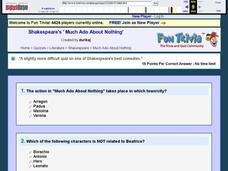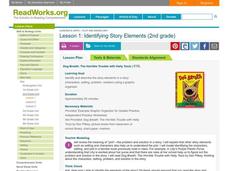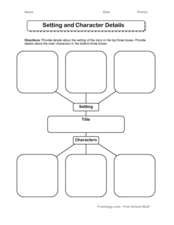Curated OER
What If: The Seed Of A Story
Students read and comprehend a piece of fictional writing, analyze how setting, characterization, and plot affect the theme of a story and work in a group to create a new writing assignment. This 5-day plan culminates in students writing...
Curated OER
Awesome Allegories
Studenets are told that Peter Paul Rubens was born on June 28, 1577, in Siegen, Germany. They create their own allegorical painting, think of a favorite story. Students write a summary of one scene in that story, using Crayola Erasable...
Curated OER
Shakespeare's Much Ado About Nothing: Fun Trivia Quiz
Quiz your class on Shakespeare's Much Ado About Nothing. This online interactive resource asks fifteen multiple choice and true/false questions. While most of the questions are surface level and based on basic plot comprehension, this...
Curated OER
It's All in the Fluency
Take a trip to the library! Elementary schoolers visit the library and choose books to read independently. They use the cover-up method of deciphering unknown words and use timed-readings to increase fluency. They discuss characters,...
Curated OER
To Kill a Mockingbird Details: Fun Trivia Quiz
Give this quiz to your class if you'd like to test their knowledge of ten details in To Kill a Mockingbird. This quiz is based on basic comprehension and recall of the text. While this is not the most academically challenging quiz, it...
Curated OER
Writing Morning: Narrative Setting
Provide an overview of setting in a narrative. Learners discuss story elements, focusing on setting. Then, they set the scene for an imaginary world using their five senses. This is a great way to help your class better understand this...
Curated OER
Is there a map in that story?
Eighth graders examine different pieces of literature from specific isolated Pacific islands. In this Geography instructional activity, 8th graders read and interpret a written selection. Students construct a map of the stories setting.
Curated OER
Story Webbing: Tennessee Blueprint
In this Tennessee Blueprint worksheet, 6th graders complete a story web for Tennessee Blueprint including setting, characters, point of view, and more. Students complete 9 sections.
Curated OER
Identify and Analyze Literary Concepts
Students explore plot structure, conflict, setting, and mood. In this literary elements lesson, students read Rosa Parks, My Story and complete the provided plot outline worksheets. Students discuss the text elements of non-fiction pieces.
Curated OER
Visualizing A Setting
Third graders use context clues from the text of the story Rainy Day to determine the setting. In this setting lesson plan, 3rd graders determine the time and place by visualizing.
Curated OER
Lesson 1: Setting impact on the Plot
Fourth graders see how the setting affects the plot. In this setting lesson, 4th graders listen to The Three Brothers : A German Folktale by Carolyn Croll and see how the setting affects the outcome of the story. They read a new story...
Curated OER
Identifying Story Elements
Second graders explore story elements. In this language arts lesson, 2nd graders identifying characters, setting, and plot in familiar stories. Students listen to a story and complete a graphic organizer.
Curated OER
Changing Setting in a Story
Second graders explore how the setting in a story changes throughout. In this language arts instructional activity, 2nd graders read a story and identify the setting at various points within the story. Students describe the changes in...
Curated OER
When (Seasons, Day, or Night)
Practice identifying the setting with a reading activity. Kindergartners find the setting of a story by observing when the story takes place. They read the book Look! Snow! by Kathryn O. Galbraith and decide in which season the story...
Curated OER
Setting and Character Details
In this setting and character worksheet, students provide details about the setting and character in this graphic organizer. Students provide 3 details for each.
Curated OER
Reading Short Stories
In this graphic organizer worksheet, students fill in the graphic organizer with the predictions, settings, characters, background, and more for short stories. Students complete 5 sections.
Curated OER
Story Map
In this story map learning exercise, students read a story and find the different story elements. They fill in the setting, characters, conflict, and climax.
Curated OER
Lesson One: How Change Affects Our Lives
Sixth graders discuss fears and how their lives change as they grow up. In this change lesson, 6th graders read the poem "Whatif" by Shel Silverstein. They discuss things they are afraid of or what they used to be afraid of.
Curated OER
Story Elements/ Setting
Students practice the story element of setting. In this setting lesson plan, students listen to the story Tulip Sees America by Cynthia Rylant. They discuss and describe the places that Tulip saw in the story.
Curated OER
Story Outline
Students examine the qualities of a piece of writing. In this language arts lesson, students begin writing by following an outline for what goes into a story. Students illustrate their story when it is finished and share their stories...
Curated OER
Annie's Gifts: comprehension skills
In this comprehension skills worksheet, students read the book Annie's Gifts and complete comprehension activities. Students complete 5 activities including problem/solution, setting, making predictions, making inferences, and drawing...
Curated OER
What's My Job?: comprehension skills
In this comprehension skills instructional activity, 2nd graders read the book What's My Job? and complete comprehension activities. Students complete 5 activities including setting, character traits, summarizing, main idea/details, and...
Curated OER
Writing a Short Story - Weather
Students write a short story based on the weather condition they chose. in this short story lesson plan, students must include a theme, setting, characters, and plot.
Curated OER
Setting in The Hobbit by J.R.R. Tolkien
Students explore The Hobbit by J.R.R Tolkien. In this literature lesson, students read the book, paying close attention to the different habitats described. Students draw a picture of each of the habitats and include a written description.

























